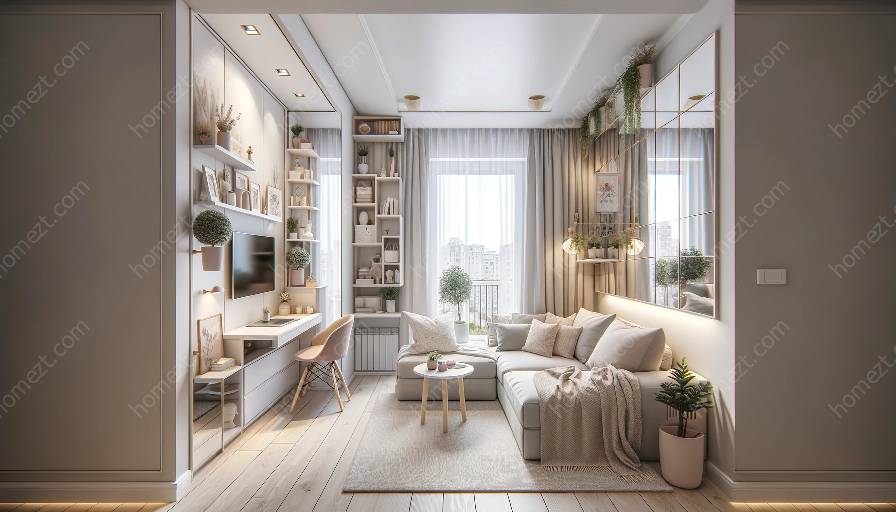Small space living can have several psychological impacts on individuals, including feelings of confinement, stress, and reduced productivity. However, interior design can play a crucial role in addressing these challenges and creating functional, aesthetically pleasing small spaces. By understanding the psychological effects of small space living and implementing thoughtful design strategies, individuals can enhance their well-being and maximize the potential of their compact living areas.
The Psychological Impacts of Small Space Living
Living in a small space can have a significant influence on one's mental and emotional well-being. Understanding the psychological impacts of small space living is essential in developing effective interior design solutions to mitigate these effects. Some common psychological impacts of small space living include:
- Feelings of Confinement: Small living spaces can evoke a sense of confinement and claustrophobia, leading to feelings of discomfort and unease.
- Increased Stress: Limited space can contribute to elevated stress levels, as individuals may feel overwhelmed by the lack of room for storage and movement.
- Reduced Productivity: Small spaces can hinder productivity, as there may be limited opportunities for creating dedicated work or study areas.
- Impact on Mental Health: The overall atmosphere of a small living space can influence mental well-being, potentially leading to feelings of depression or anxiety.
Understanding these psychological impacts is crucial in developing effective interior design strategies for small spaces.
How Interior Design Can Address Psychological Impacts of Small Space Living
Interior design plays a pivotal role in addressing the psychological impacts of small space living. By integrating thoughtful design elements and space-maximizing techniques, interior designers can create environments that promote well-being and functionality. Here are some ways in which interior design can address the psychological impacts of small space living:
Maximizing Natural Light:
Introducing ample natural light into a small space can create a sense of openness and airiness, counteracting feelings of confinement and enhancing overall mood and well-being. Interior designers can utilize large windows, strategically placed mirrors, and light-colored surfaces to optimize natural light within a compact living area.
Optimizing Storage Solutions:
Effective storage solutions are integral to reducing clutter and minimizing stress in small spaces. Interior designers can incorporate multifunctional furniture with built-in storage, vertical storage solutions, and hidden compartments to maximize space and create a sense of organization and tidiness.
Creating Multifunctional Areas:
Small spaces benefit from multifunctional design concepts that allow areas to serve multiple purposes. Interior designers can create versatile furniture arrangements, convertible pieces, and adaptable layouts to accommodate various activities, from work and study to relaxation and entertainment, thus addressing the challenge of reduced productivity in small living spaces.
Incorporating Visual Illusions:
Strategic use of design elements such as mirrors, reflective surfaces, and optical illusions can visually expand small spaces, helping to counteract feelings of confinement and creating the illusion of a more spacious environment. Interior designers can employ techniques that play with perspective and depth to enhance the perceived size of a small living area.
Utilizing Color Psychology:
Color selection can significantly impact the psychological atmosphere of a small space. Interior designers can leverage the principles of color psychology to create a harmonious and uplifting environment, utilizing light and soothing hues to promote relaxation and well-being, while strategically incorporating pops of vibrant color to add visual interest and energy.
Tips for Utilizing Small Spaces
Aside from interior design solutions, there are practical tips that individuals can implement to optimize their experience of living in small spaces:
- Declutter Regularly: Regular decluttering helps to maintain a sense of space and organization within a small living area, reducing feelings of stress and enhancing overall comfort.
- Embrace Minimalism: Adopting a minimalist lifestyle and mindset can complement small space living, emphasizing the beauty of simplicity and reducing the need for excessive material possessions.
- Utilize Vertical Space: Making use of vertical space for storage and decor can maximize the functional potential of a small area, allowing for efficient organization and visual interest.
- Invest in Multi-Functional Furniture: Selecting furniture pieces with multiple functions, such as sofa beds, expandable tables, and nesting stools, can optimize space utilization and versatility in a small living space.
- Personalize with Thoughtful Decor: Thoughtfully selecting decor and personalizing the space with meaningful items can create a sense of identity and warmth, enhancing the psychological comfort of a small living area.
By combining interior design strategies with practical tips for utilizing small spaces, individuals can create functional, visually appealing, and psychologically supportive living environments.






































